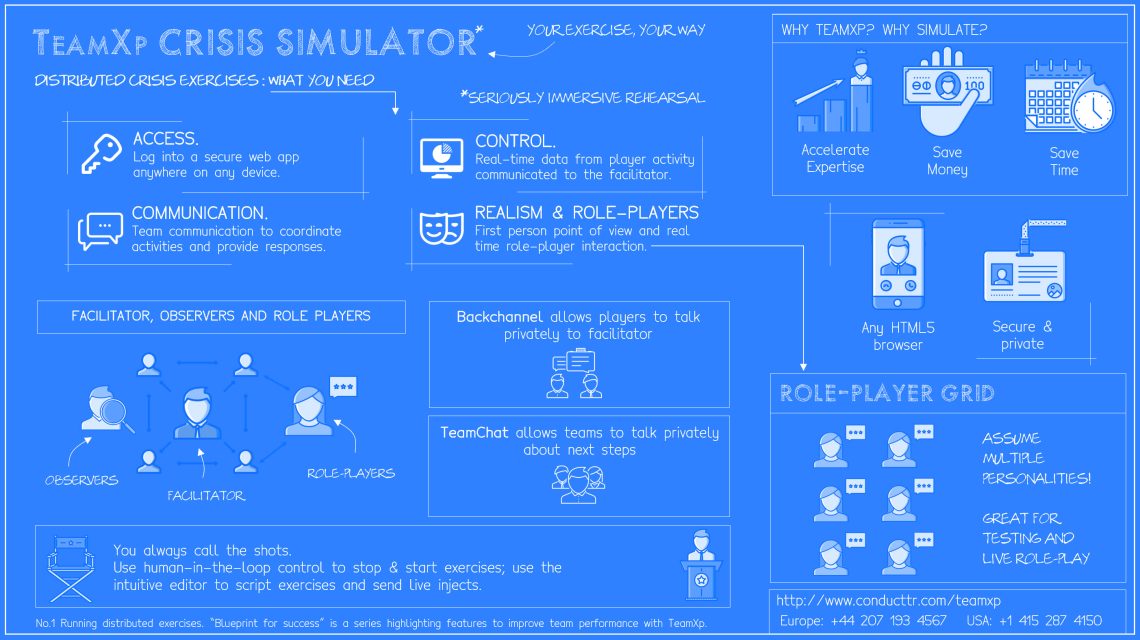Large organizations have the need to train staff across the world but bringing them altogether to the same physical location is expensive in terms of travel & accommodation costs and it takes them out of the workplace. The issue is made worse when you need to train senior members of staff because their availability is at a premium, time away from the workplace is costlier and coordinating diaries trickier – meaning that important rehearsals are postponed time and again.
Far better to have crisis teams train wherever they are in the world and you manage everything remotely.
What you need to run distributed crisis exercises:
- Access
- Communication
- Control
- Realism & role-players
Access
Players need to log into a secure web application wherever they are on any device. The application needs to simulate social media, email, instant messenger, phone calls and any other websites and systems the company uses.
Use of 2-step authentication and whitelisting ensures only those registered to login can do so.
Using a secure HTML5 browser means team members can participate in the office, at home, or even in transit at the airport.
Communication
Teams need the ability to communicate with each other to coordinate activities and provide a coherent response.
TeamChat provides teams with a whatsapp/slack-type channel for intra-team instant communication so that all messaging is kept within the exercise.
Another feature, Backchannel provides an out-of-world instant messaging link between players and the exercise facilitator.
Multiple languages needn’t be a problem if you only speak one language. Important communications can be pre-scripted in the correct language and automatically sent to the right person at at the right time in the right language. Local or remote observers and role-players who speak the right language can form part of the exercise control team and interact and translate to your language.
Control
Without visual contact with the players, the facilitator must rely on the technology to be the local eyes and ears.
Real time data from player activity is communicated to a facilitator dashboard to show who is active, when and what choices they’re making.
All open text communications such a tweets sent, Facebook posts made, emails sent and so on are journaled (i.e. blind copied) to the facilitator dashboard making it easy and convenient for the facilitator to track what’s going on.
The backchannel provides an additional convenient, out-of-world, way to chat directly with a player to ask and answer questions
Local observers can help too. Identifying someone as an observer allows them access to the facilitator dashboard to see what’s going on but without the controls to direct the exercise. They can still feedback information to the facilitator and of course answer questions in the local language if necessary.
Realism
How to create realism is a blog post in itself but an important part is that it feels like the real thing:
- Player does what they are expected to do
- Stakeholders and the world reacts to their decisions
- Details are correct and accurate
The first part is achieved with a web app that presents a first-person point-of-view of the communications channels and decision support systems they might have access to: email, whatsapp/slack, Twitter, Facebook, TV, share prices, help desk and others.
Any channel can be available to all players on their device or, if players around the world are huddled into local incident rooms, a channel can be made available only as a shared channel on a master TV screen in that room. What’s screened in room 2 in Jakarta can be the same or different to what’s screened in room 5 in Dubai.
Fake websites can be created and displayed in the TeamXp web application and switched up or down on demand. For example, a “live” website is changed to one that’s been hacked or one with a warning that the server is down. Again, this can vary by location with the New York website going down and the London website staying up.
A graph channel can be used to display company share price or social media analytics – providing instant feedback to players about how their actions are affecting the outside world.
The list goes on….
Role-players
Role-players can be located anywhere in the world and either work together or alone.
They have full access to Twitter to reply and tweet as their persona and can answer or make real phone calls.
With TeamXp, role-players can be primed and prepared with real-time information about the player so that live in-person interaction is meaningful. More on this in another post!
Conclusion
Running a crisis exercise with team players geographically distributed and the exercise control team elsewhere is not only possible but often preferable since it saves time and money and can increase the likelihood and frequency of running crisis exercises.
Check out TeamXp and start accelerating your team’s performance – wherever they are in the world!



